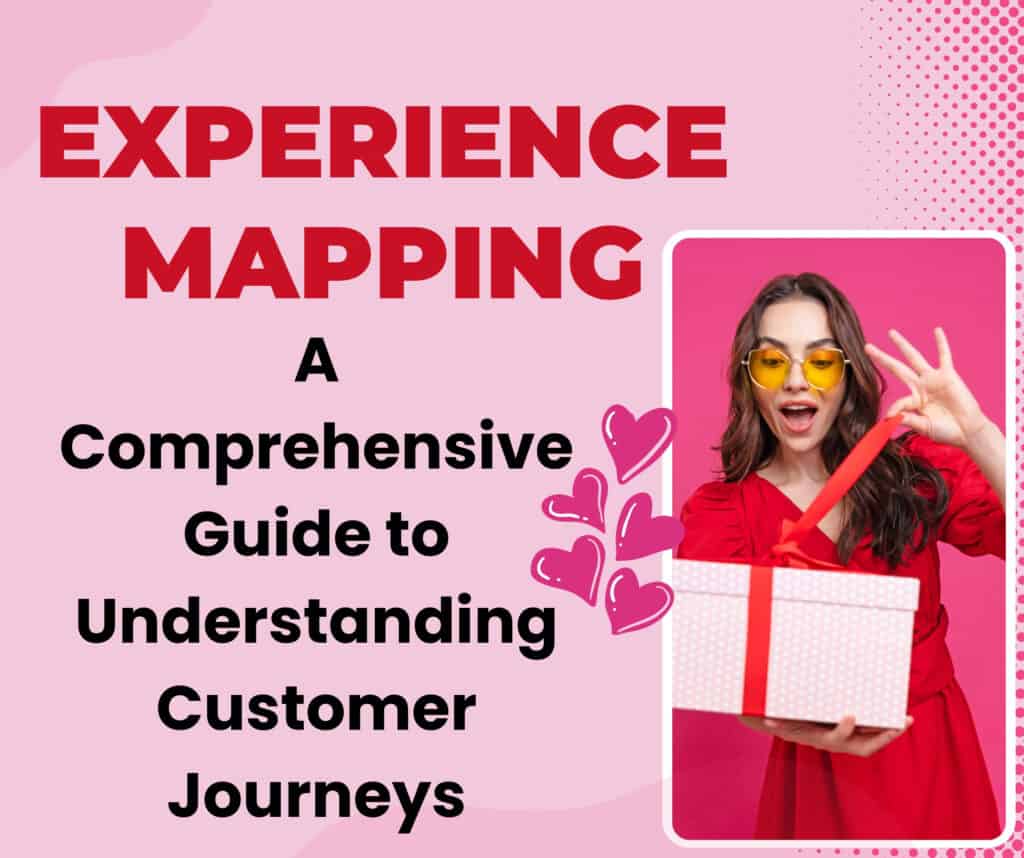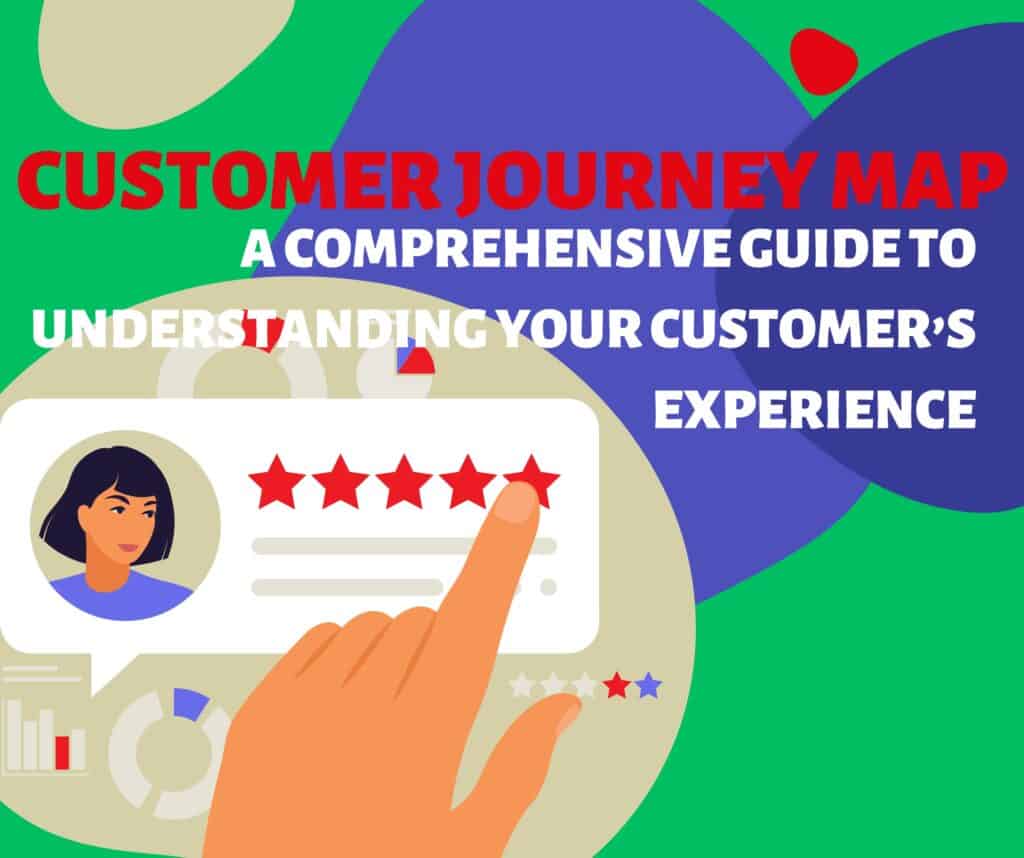In today’s competitive business landscape, understanding your customers is more critical than ever. One powerful tool that helps businesses gain deeper insights into their customers’ experiences is experience mapping. Experience mapping is a strategic approach to visualizing and analyzing the interactions customers have with a product, service, or organization over time. By creating a detailed map of these interactions, businesses can uncover valuable insights that drive improvements and enhance overall customer satisfaction.
Brief Explanation of Experience Mapping:
Experience mapping is a technique used to document and analyze the various touchpoints and stages of a customer’s journey. It involves creating visual representations of how customers interact with a company, from initial contact through to post-purchase. These maps help illustrate the entire experience, including the emotions and challenges customers encounter along the way. By capturing this information, experience mapping provides a comprehensive view of the customer’s perspective, enabling businesses to identify pain points, opportunities for improvement, and areas where they excel.
Create your own income stream. Start your online business here.
Try Wealthy Affiliate (For Free).
Importance of Understanding Customer Journeys:
Understanding customer journeys is crucial for several reasons. Firstly, it allows businesses to gain a deeper understanding of their customers’ needs, preferences, and behaviors. This insight helps tailor products and services to better meet customer expectations and improve satisfaction. Secondly, by identifying pain points and bottlenecks in the customer journey, businesses can make targeted improvements that enhance the overall experience. This can lead to increased customer loyalty, positive word-of-mouth, and ultimately, greater business success. Lastly, a well-mapped customer journey helps align internal processes and strategies with customer needs, ensuring that every touchpoint is optimized for a seamless and engaging experience.
Overview of What the Article Will Cover:
In this article, we will explore the concept of experience mapping in depth. We’ll start by defining what experience mapping is and why it’s a valuable tool for businesses. We’ll then delve into the different types of experience maps, including customer journey maps, service blueprints, and user journey maps, highlighting their unique features and applications. Following that, we’ll discuss the numerous benefits of experience mapping, such as improved customer understanding and enhanced user experience.
Next, we’ll provide a step-by-step guide on how to create an effective experience map, from defining objectives to implementing changes based on the insights gained. We’ll also review various tools and resources that can aid in the experience mapping process, including software platforms and templates. Finally, we’ll share best practices to ensure your experience mapping efforts are successful and impactful.
By the end of this article, you’ll have a thorough understanding of experience mapping and be well-equipped to start applying these techniques to enhance your customer interactions and drive business success.
What is Experience Mapping?
Definition of Experience Mapping:
Experience mapping is a strategic tool used to visualize and analyze the interactions that customers or users have with a product, service, or brand over time. It involves creating a detailed map that outlines each touchpoint, action, and emotion experienced by the customer from the initial point of contact through the entire customer journey. This visualization helps businesses gain a holistic understanding of the customer experience, highlighting how customers perceive and engage with various aspects of the company.
At its core, experience mapping aims to capture the customer’s perspective in a structured format, making it easier to identify both positive and negative aspects of their interactions. This approach not only reveals how customers navigate through their journey but also provides insights into their feelings and thoughts at each stage.
Purpose and Benefits:
The primary purpose of experience mapping is to provide a clear and comprehensive view of the customer journey. This understanding allows businesses to make informed decisions and improvements. Here are some key benefits of experience mapping:
- Enhanced Customer Insight:
- Experience mapping helps businesses gain a deeper understanding of customer needs, behaviors, and pain points. By visualizing the customer journey, companies can identify what matters most to their customers and address any issues that arise.
- Improved Customer Experience:
- By pinpointing areas where customers face challenges or frustrations, businesses can implement targeted solutions to enhance the overall experience. This leads to higher satisfaction and loyalty among customers.
- Alignment of Internal Processes:
- Experience maps help align internal teams and processes with the customer journey. This ensures that every department understands their role in contributing to a seamless customer experience.
- Informed Decision Making:
- With a clear view of the customer journey, businesses can make data-driven decisions and prioritize initiatives that have the greatest impact on customer satisfaction and business success.
- Identification of Opportunities:
- Experience mapping reveals gaps and opportunities for innovation. Businesses can identify areas where they can differentiate themselves from competitors and create more engaging and valuable experiences.
Key Components of an Experience Map:
An effective experience map typically includes several key components that provide a comprehensive view of the customer journey:
- Customer Personas:
- Detailed profiles of different customer segments, including their goals, needs, and behaviors. Personas help to tailor the experience map to specific user groups.
- Touchpoints:
- Points of interaction between the customer and the company, such as website visits, customer service calls, or in-store experiences. Each touchpoint is mapped to show how and when customers interact with the business.
- Customer Actions:
- Specific actions taken by customers at each touchpoint, such as making a purchase, seeking support, or providing feedback. Mapping these actions helps to understand the sequence of the customer journey.
- Emotions and Feelings:
- Insights into how customers feel at each stage of their journey, including positive, negative, or neutral emotions. This helps to identify areas where emotional experiences can be improved.
- Pain Points and Challenges:
- Problems or obstacles that customers encounter during their journey. Identifying these pain points is crucial for making improvements and addressing customer frustrations.
- Opportunities for Improvement:
- Areas where the customer experience can be enhanced or where new opportunities can be explored. This component helps to focus efforts on areas with the greatest potential for impact.
- Supporting Data and Insights:
- Data and research that provide context and validation for the experience map. This may include customer feedback, surveys, and analytics.
Types of Experience Maps
Experience mapping encompasses various types of maps, each serving different purposes and providing unique insights. Understanding these types can help businesses select the most appropriate method for their specific needs. Below, we explore three primary types of experience maps: Customer Journey Maps, Service Blueprints, and User Journey Maps.
Disclosure: Some of the links in this post are affiliate links, which means I may earn a commission if you make a purchase. These resources provide access to essential tools for your online journey.
Try Wealthy Affiliate (For Free).
Customer Journey Maps
Focus on Customer Interactions: Customer Journey Maps (CJMs) are designed to illustrate the entire journey of a customer as they interact with a company, product, or service. These maps track each touchpoint or interaction the customer has, from the first point of contact to the final outcome, such as making a purchase or seeking support. The focus is on capturing the customer’s experience and emotions at each stage of their journey.
Examples and Applications:
- Retail: A customer journey map for an online retailer might show the steps from discovering the website through to completing a purchase and receiving post-purchase support.
- Healthcare: In a healthcare setting, a journey map could track a patient’s experience from booking an appointment to receiving treatment and follow-up care.
- Travel: For a travel company, the map might include stages from researching destinations to booking a trip, experiencing the vacation, and providing feedback.
By visualizing the customer journey, businesses can identify pain points and opportunities for improvement, ensuring a smoother and more satisfying experience for their customers.
Service Blueprints
Detailed View of Service Processes: Service Blueprints provide a more detailed view of the internal processes and interactions that support customer experiences. They map out not only the customer journey but also the backend processes that enable each interaction. This includes employee actions, technology systems, and other organizational elements that contribute to delivering the service.
How They Differ from Customer Journey Maps:
- Scope: While CJMs focus primarily on the customer’s perspective, Service Blueprints provide a comprehensive view of both customer interactions and internal operations. This dual perspective helps to understand how various service elements work together to deliver the customer experience.
- Detail: Service Blueprints include layers of information such as frontstage (customer-facing) and backstage (internal) processes. They detail the roles of different team members and systems involved in delivering the service, which is not typically covered in a CJM.
For example, a service blueprint for a hotel might map the guest experience from booking a room to check-in, room service, and check-out, while also detailing the internal processes such as reservation management, housekeeping, and customer service.
User Journey Maps
Emphasis on User Interaction with Products: User Journey Maps focus specifically on how users interact with a product or service. They highlight the sequence of actions and touchpoints a user experiences while using a product, emphasizing usability and user satisfaction. The goal is to understand how users engage with the product, what challenges they encounter, and how they achieve their goals.
Ideal Use Cases:
- Product Development: For software or app developers, user journey maps can illustrate how users navigate through features, identify pain points, and optimize the user interface for a better experience.
- E-commerce: An e-commerce site might use a user journey map to understand how users search for products, add items to their cart, and complete the checkout process.
- Consumer Electronics: In the case of a new electronic device, a user journey map could detail the user’s experience from unboxing and setup to daily usage and troubleshooting.
Benefits of Experience Mapping
Experience mapping offers a range of benefits that can significantly enhance a business’s understanding of customer interactions and improve overall operations. Below, we delve into some key advantages of experience mapping:
Improved Customer Understanding
Identifying Pain Points and Opportunities: One of the most valuable benefits of experience mapping is the ability to gain a deeper understanding of the customer journey. By visualizing each stage of the customer’s interaction with your brand, you can identify specific pain points and challenges that customers face. These pain points may include difficulties with navigating a website, delays in service, or frustrations with product features.
Ready for a new opportunity? Click to begin.
Try Wealthy Affiliate (For Free).
In addition to uncovering problems, experience mapping highlights opportunities for improvement and innovation. For example, if customers consistently struggle with a particular aspect of your service, you can address this issue to enhance their overall experience. Conversely, identifying positive touchpoints allows you to reinforce and expand on successful aspects of the customer journey.
Enhanced User Experience
Tailoring Solutions Based on Insights: Experience mapping provides detailed insights into how users interact with your product or service, including their preferences, needs, and frustrations. This understanding enables you to tailor solutions specifically to address user needs and improve their overall experience.
For instance, if a user journey map reveals that users find a specific feature confusing, you can simplify the design or provide clearer instructions. By addressing these issues directly, you can create a more intuitive and enjoyable experience for your users. Enhanced user experiences not only lead to higher satisfaction but also increase customer loyalty and advocacy.
Streamlined Processes
Better Alignment of Team Efforts and Resources: Experience mapping helps align various departments and teams within an organization by providing a unified view of the customer journey. This alignment ensures that everyone—from marketing and sales to customer service and product development—is working towards the same goals and understands their role in the customer experience.
By visualizing the entire process, teams can identify areas where processes overlap or where there may be gaps in service delivery. This clarity allows for more efficient use of resources, reduces redundancy, and ensures that efforts are focused on areas that will have the most significant impact on customer satisfaction.
Informed Decision Making
Data-Driven Approach to Strategy: Experience mapping transforms customer insights into actionable data, enabling businesses to make informed decisions based on real experiences rather than assumptions. This data-driven approach helps prioritize initiatives and investments that will deliver the most value to customers.
For example, if experience mapping shows that a significant number of customers drop off during the checkout process, you can prioritize optimizing this stage of the journey. Similarly, insights from experience mapping can guide strategic decisions such as product development, marketing strategies, and customer service improvements.
Steps to Create an Effective Experience Map
Creating an effective experience map involves a systematic approach to understanding and improving customer interactions. Here’s a detailed guide to the steps involved in developing a meaningful experience map:
Step 1: Define Objectives
Clarify Goals and Scope: Before diving into experience mapping, it’s crucial to establish clear objectives and define the scope of the project. Ask yourself what you aim to achieve with the experience map. Are you focusing on improving a specific aspect of the customer journey, such as reducing churn or enhancing onboarding? Or are you looking at the entire customer experience across multiple touchpoints?
Defining these goals helps to narrow down the areas of focus and ensures that the mapping process is aligned with your business objectives. It also helps in determining the level of detail required and the resources needed for the project.
Step 2: Gather Data
Collect Customer Feedback and Analytics: Accurate and comprehensive data is the foundation of a successful experience map. Start by collecting a range of data sources, including:
- Customer Feedback: Use surveys, interviews, focus groups, and reviews to gather direct input from customers about their experiences, pain points, and preferences.
- Analytics: Leverage web and app analytics to understand how customers interact with your digital platforms. Look at metrics such as click paths, bounce rates, and conversion rates to gain insights into customer behavior.
- Customer Support Data: Analyze records from customer support interactions to identify recurring issues and areas where customers frequently seek help.
Combining quantitative data with qualitative insights provides a holistic view of the customer experience, which is essential for creating an accurate experience map.
Step 3: Create Personas
Develop Detailed Customer Profiles: Customer personas are fictional, generalized representations of your ideal customers. Creating detailed personas involves gathering demographic, psychographic, and behavioral information to develop profiles that reflect the diversity of your customer base.
Start building your online business today. Click below.
Try Wealthy Affiliate (For Free).
Include details such as:
- Demographics: Age, gender, location, and occupation
- Psychographics: Interests, values, and lifestyle
- Behavioral Traits: Purchasing habits, product usage, and pain points
Personas help to contextualize the experience map and ensure that the insights and improvements are tailored to the specific needs and preferences of different customer segments.
Step 4: Map Customer Journeys
Visualize Touchpoints and Interactions: With objectives, data, and personas in place, start mapping the customer journey. Visualize the sequence of touchpoints and interactions customers have with your brand. This includes:
- Touchpoints: Channels and interactions such as website visits, customer service calls, email communications, and social media engagement.
- Interactions: Actions customers take at each touchpoint, such as searching for information, making a purchase, or requesting support.
Use visual tools like flowcharts, diagrams, or digital mapping software to create a clear and engaging representation of the customer journey.
Step 5: Identify Pain Points and Opportunities
Analyze Gaps and Areas for Improvement: Examine the experience map to identify pain points where customers encounter difficulties or frustrations. Look for patterns and trends in the data that highlight areas where the customer experience falls short.
Additionally, identify opportunities for improvement and innovation. These might include streamlining processes, enhancing features, or introducing new touchpoints that can add value to the customer experience. Addressing these areas helps to refine the journey and improve overall satisfaction.
Step 6: Implement Changes
Develop Action Plans Based on Insights: Based on the insights gained from the experience map, develop action plans to address identified pain points and leverage opportunities for improvement. These plans should include:
- Specific Actions: Clear steps to implement changes, such as redesigning a website feature or improving customer support processes.
- Responsibilities: Assign tasks to relevant team members or departments to ensure accountability and effective execution.
- Timelines: Set deadlines for implementing changes and achieving milestones.
Implementing these changes helps to enhance the customer experience and align it with your defined objectives.
Step 7: Review and Iterate
Regularly Update the Map Based on New Data: Experience mapping is not a one-time exercise but an ongoing process. Regularly review and update the experience map to reflect new data, customer feedback, and changes in the business environment. This iterative approach ensures that the map remains relevant and continues to provide valuable insights.
Tools and Resources for Experience Mapping
Creating and maintaining an effective experience map can be facilitated by using various tools and resources. These can help streamline the process, provide structure, and enhance the quality of your mapping efforts. Below, we explore different categories of tools and resources, including software and platforms, templates and frameworks, as well as books and courses.
Software and Platforms
Examples: UXPressia, Smaply, Miro:
- UXPressia:
- Overview: UXPressia is a user-friendly platform designed specifically for creating customer journey maps, personas, and impact maps. It offers a range of customizable templates and interactive features that make it easy to visualize and share experience maps.
- Key Features: Drag-and-drop interface, collaborative tools, real-time updates, and the ability to integrate with other data sources. UXPressia also provides analytics and reporting tools to track changes and improvements over time.
- Smaply:
- Overview: Smaply provides a suite of tools for customer journey mapping, persona creation, and stakeholder maps. It is known for its comprehensive features that cater to both small and large teams.
- Key Features: Flexible mapping options, stakeholder mapping, journey visualization, and the ability to create detailed personas. Smaply also supports team collaboration and allows for the integration of different data types.
- Miro:
- Overview: Miro is a versatile online whiteboard tool that can be used for a variety of mapping and brainstorming activities, including experience mapping. Its flexible canvas and collaborative features make it suitable for teams working on customer journey maps and other strategic visualizations.
- Key Features: Customizable templates, real-time collaboration, integrations with other tools (e.g., Slack, Google Drive), and a wide range of shapes and icons for mapping purposes.
Templates and Frameworks
Access to Customizable Templates: Templates and frameworks are invaluable for structuring your experience maps and ensuring consistency across different projects. Many tools and platforms offer customizable templates that can be adapted to your specific needs. Here’s how to access and use them:
- Pre-Made Templates:
- Many software platforms, such as UXPressia and Smaply, provide pre-made templates for customer journey maps, personas, and service blueprints. These templates come with predefined sections and formats that you can customize based on your data and objectives.
- Customizable Frameworks:
- You can also find frameworks and guides online that provide a structured approach to experience mapping. Websites like HubSpot and Smartsheet offer downloadable templates and examples that can be tailored to your specific requirements.
- Design Resources:
- Platforms like Canva and Adobe Spark provide design resources and templates that can be used to create visually appealing experience maps. These tools offer drag-and-drop features and design elements that help in crafting professional-looking maps.
Books and Courses
Recommended Reading and Learning Materials:
- Books:
- “Mapping Experiences: A Complete Guide to Creating Value through Journeys, Blueprints, and Diagrams” by Jim Kalbach: This book offers a comprehensive guide to experience mapping, including practical advice and real-world examples.
- “This Is Service Design Doing: Applying Service Design Thinking in the Real World” by Marc Stickdorn, Adam Lawrence, and others: A follow-up to “This Is Service Design Thinking,” this book provides hands-on techniques and tools for applying service design principles, including experience mapping.
- Courses:
- Coursera: Platforms like Coursera offer courses on user experience and service design that cover experience mapping techniques. Look for courses like “User Experience Design Fundamentals” or “Introduction to Service Design.”
- LinkedIn Learning: Offers courses such as “Customer Journey Mapping” and “Service Design Thinking,” which include practical exercises and case studies to enhance your skills in experience mapping.
- Online Resources:
- Blogs and Articles: Websites like Nielsen Norman Group, Smashing Magazine, and UX Design.cc regularly publish articles and case studies on experience mapping and related topics.
- Webinars and Workshops: Attend webinars and workshops hosted by industry experts and organizations to stay updated on the latest trends and best practices in experience mapping.
Best Practices for Experience Mapping
To ensure that your experience mapping efforts are effective and yield meaningful insights, it’s important to follow best practices. These practices help create accurate, actionable, and visually engaging maps that truly reflect the customer experience. Below are some key best practices to consider:
Engage Stakeholders
Collaborate with Team Members and Customers: Engaging a diverse group of stakeholders is crucial for creating a comprehensive and accurate experience map. Involve both internal team members and external customers in the mapping process:
- Internal Collaboration:
- Cross-Functional Teams: Include representatives from different departments such as marketing, sales, customer support, and product development. Each team has unique insights and perspectives on customer interactions and internal processes.
- Workshops and Meetings: Organize workshops and meetings to gather input, discuss findings, and align on the objectives of the experience map. Collaborative sessions help ensure that all relevant aspects of the customer journey are considered.
- Customer Involvement:
- Customer Interviews and Surveys: Collect feedback directly from customers to understand their experiences, expectations, and pain points. This firsthand input is invaluable for creating an accurate and empathetic representation of the customer journey.
- User Testing: Conduct usability tests with real users to observe their interactions with your product or service. This provides concrete data on how customers navigate and engage with your offerings.
Use Real Data
Base Maps on Actual Customer Interactions: To create a meaningful and reliable experience map, it’s essential to use real data rather than assumptions. Base your maps on actual customer interactions and feedback:
- Customer Feedback:
- Surveys and Feedback Forms: Analyze data from customer surveys, feedback forms, and reviews to gather insights on their experiences and preferences.
- Support Tickets and Complaints: Review records from customer support interactions to identify common issues and areas for improvement.
- Analytics Data:
- Behavioral Analytics: Use web and app analytics tools to track user behavior, such as page views, click paths, and conversion rates. This data helps to identify how customers interact with your digital platforms.
- Journey Analysis: Look at end-to-end customer journeys and identify patterns in how users progress through different stages of their interaction with your brand.
Keep It Visual
Utilize Clear and Engaging Visuals: Visualizing the customer journey effectively is key to making the experience map accessible and actionable. Use clear and engaging visuals to represent the data:
- Visual Design:
- Flowcharts and Diagrams: Use flowcharts, diagrams, and infographics to represent the sequence of touchpoints and interactions. Ensure that these visuals are easy to understand and follow.
- Icons and Color Coding: Incorporate icons, color coding, and other design elements to differentiate between different stages, touchpoints, and emotions. This enhances readability and helps highlight key aspects of the journey.
- Interactive Elements:
- Digital Tools: Leverage digital tools and platforms that allow for interactive and dynamic experience maps. Features such as clickable elements and real-time updates can make the maps more engaging and useful for collaborative work.
Continuously Update
Regularly Revise Maps to Reflect Changes: Experience mapping is an ongoing process that requires regular updates to remain relevant and useful:
- Periodic Reviews:
- Scheduled Updates: Set up regular intervals (e.g., quarterly or bi-annually) to review and update the experience map based on new data, customer feedback, and changes in the business environment.
- Feedback Loops: Implement feedback loops to gather insights from stakeholders and customers about the effectiveness of recent changes and identify new areas for improvement.
- Adapt to Changes:
- Market Trends: Stay informed about market trends and shifts in customer behavior. Update the experience map to reflect these changes and ensure that your strategies remain aligned with current customer needs.
- Business Changes: Adjust the map to accommodate changes in your business offerings, processes, or technology. This ensures that the map continues to accurately represent the evolving customer journey
Conclusion
Experience mapping is a powerful tool for gaining a deeper understanding of the customer journey and improving overall customer experiences.
Want to escape the 9-5? Start here.
Try Wealthy Affiliate (For Free).
By visualizing the various touchpoints and interactions that shape a customer’s relationship with your brand, you can uncover valuable insights, identify pain points, and discover opportunities for enhancement. This understanding enables you to make informed decisions, streamline processes, and deliver more personalized and satisfying experiences for your customers.
Recap of the Importance of Experience Mapping
Throughout this article, we’ve explored how experience mapping can transform your approach to customer experience management. From defining the concept and types of experience maps to outlining the benefits and best practices, it’s clear that experience mapping is essential for:
- Improving Customer Understanding: By identifying specific pain points and areas of opportunity, experience mapping helps you better address customer needs and enhance their overall journey.
- Enhancing User Experience: Tailoring solutions based on detailed insights from your maps ensures that you deliver a more engaging and satisfying experience.
- Streamlining Processes: Aligning team efforts and resources with the insights gained from experience mapping helps optimize operations and reduce inefficiencies.
- Informed Decision Making: Leveraging data-driven insights allows for more strategic and impactful decisions that align with customer expectations and business goals.
Encouragement to Start Mapping for Better Customer Insights
The insights gained from experience mapping are invaluable for any organization committed to improving its customer experience. By starting the experience mapping process, you embark on a journey to deeply understand and address your customers’ needs, leading to enhanced satisfaction and loyalty.
Whether you’re aiming to refine specific aspects of the customer journey or seeking a comprehensive view of the entire experience, experience mapping offers a structured approach to achieve these goals. The process might seem complex at first, but with the right tools, resources, and commitment, you can create impactful maps that drive meaningful improvements.
Call to Action: Explore Tools and Begin Creating Your Own Experience Maps
Now that you understand the importance and benefits of experience mapping, it’s time to take action. Explore the various tools and resources available to assist you in creating effective experience maps:
- Software and Platforms: Consider using tools like UXPressia, Smaply, or Miro to facilitate the mapping process and visualize customer journeys.
- Templates and Frameworks: Access customizable templates and frameworks to structure your maps and ensure consistency.
- Books and Courses: Expand your knowledge by reading recommended books and enrolling in courses to deepen your understanding of experience mapping techniques.
Begin by defining your objectives, gathering data, and engaging with stakeholders. Utilize the tools and resources at your disposal to create detailed and insightful experience maps that reflect real customer interactions. By committing to this process, you’ll be well-equipped to enhance customer experiences and drive success for your organization.
Start today, and transform your approach to understanding and improving the customer journey!
We’d love to hear from you! Experience mapping is a journey that many organizations embark on, and each one’s experience is unique. Whether you’re just getting started or have been mapping for a while, your insights and questions can provide valuable perspectives for others in the community.
Share Your Experiences: Have you implemented experience mapping in your organization? What challenges did you face, and what successes have you achieved? Share your stories and insights in the comments below to help others learn from your experiences.
Ask Questions: If you have any questions about experience mapping—whether it’s about best practices, tools, or specific techniques—feel free to ask in the comments. Our community is here to support each other, and we’ll do our best to provide helpful answers and advice.
Engage with us and join the conversation. Your contributions can make a difference and help others navigate their own experience mapping journeys!







